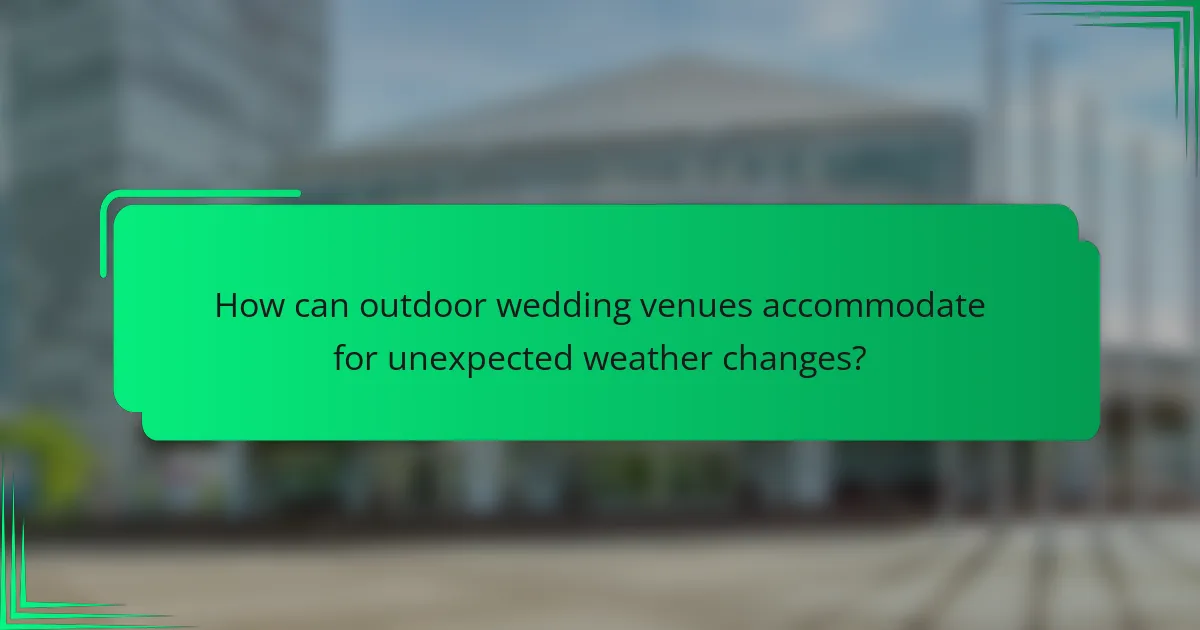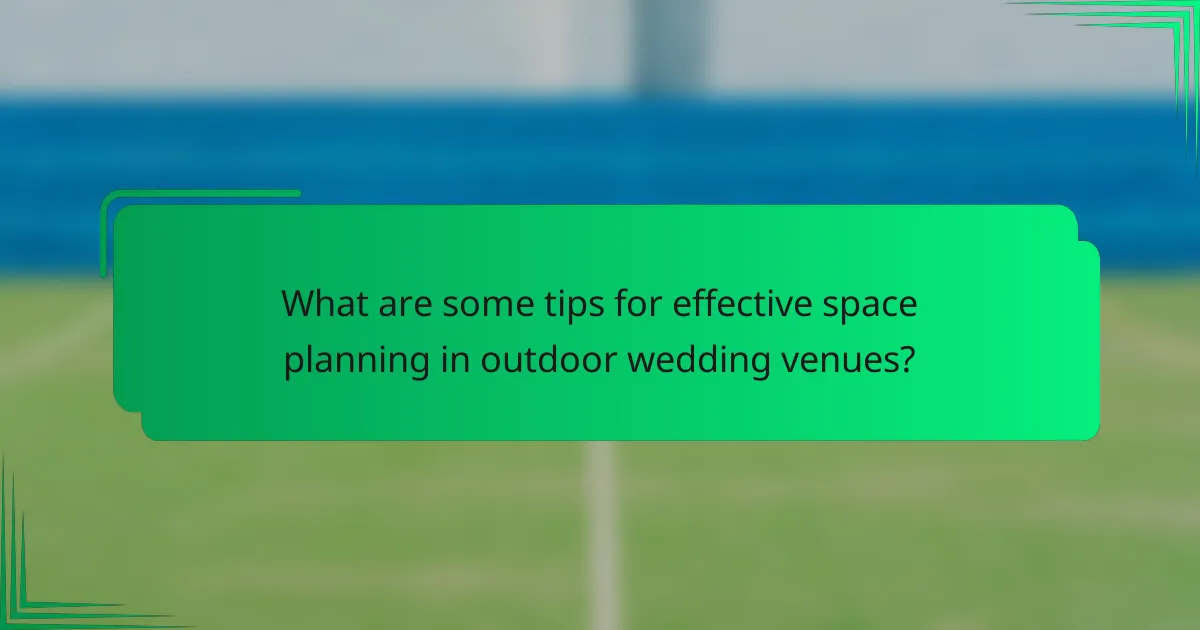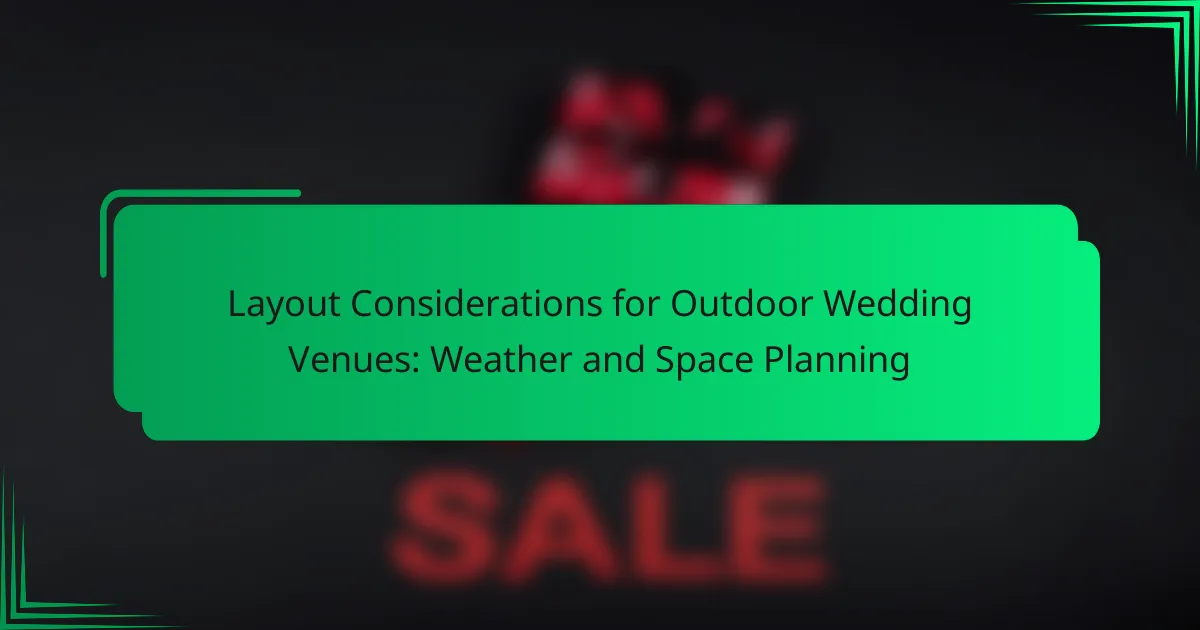Outdoor wedding venues require careful layout considerations to ensure a successful event. Key factors include adequate space for guests, effective weather protection, and accessibility for all attendees. Strategic planning involves identifying natural features for shade, designing flow for guest movement, and placing essential areas like the altar and reception thoughtfully. Contingency plans for unexpected weather changes, such as access to tents and communication strategies, are crucial for maintaining comfort. Overall, effective space planning enhances the guest experience and ensures smooth operations throughout the event.

What are the key layout considerations for outdoor wedding venues?
Key layout considerations for outdoor wedding venues include space for guests, weather protection, and accessibility. Sufficient space allows for seating, dining, and dancing areas. Weather protection options, like tents or canopies, ensure comfort in rain or sun. Accessibility must accommodate all guests, including those with mobility issues. Additionally, the layout should facilitate a smooth flow of guests during the event. Proper placement of key elements like the altar and reception area enhances the experience. Lastly, consider the surrounding environment for aesthetics and sound management.
How does weather impact the layout of outdoor wedding venues?
Weather significantly impacts the layout of outdoor wedding venues. Rain can necessitate the inclusion of tents or covered areas. This ensures guests stay dry during the ceremony and reception. Wind may require securing decorations and seating arrangements to prevent disruptions. High temperatures can influence the placement of shade structures to keep guests comfortable. Cold weather might lead to the addition of heaters or blankets for warmth. Seasonal factors, such as blooming flowers, can affect the aesthetic arrangement of the venue. Overall, weather conditions dictate practical and aesthetic decisions in venue layout.
What types of weather should be planned for when designing an outdoor wedding layout?
When designing an outdoor wedding layout, it is essential to plan for various types of weather. Key weather conditions to consider include rain, wind, heat, and cold. Rain can disrupt the event and damage decorations, so having a plan for tents or indoor alternatives is crucial. Wind can affect the stability of structures and decorations, necessitating secure setups. Heat can lead to discomfort for guests, making shade and hydration options important. Cold weather can require heating solutions or blankets for guests. Each of these weather types can significantly impact the comfort and enjoyment of the event.
How can weather forecasts influence the decision-making process for layout planning?
Weather forecasts significantly influence layout planning for outdoor wedding venues. Accurate predictions allow planners to anticipate conditions such as rain, wind, or temperature. This foresight enables adjustments to seating arrangements, tent placements, and decor setups. For example, if rain is forecasted, planners may choose to set up a tent or relocate the ceremony indoors. Similarly, high winds may require securing decorations and equipment more effectively. Historical data shows that outdoor events are often impacted by weather, with 30% of outdoor weddings rescheduled due to inclement conditions. Thus, utilizing weather forecasts enhances the overall success and comfort of the event.
What are the spatial requirements for different outdoor wedding setups?
Outdoor wedding setups require varying spatial dimensions based on the type of arrangement. A traditional ceremony setup typically needs at least 20 feet by 30 feet for the altar and seating. A reception area with tables and chairs requires a minimum of 10 square feet per guest. For a buffet setup, allocate an additional 5 to 10 feet for food stations and guest flow. Dance floors should be around 12 by 12 feet for small gatherings, increasing to 20 by 20 feet for larger groups. Tents should provide at least 100 square feet per 8 guests seated. These dimensions ensure comfort and accessibility for all attendees.
How do guest counts affect space planning for outdoor weddings?
Guest counts significantly influence space planning for outdoor weddings. Higher guest counts require larger areas for seating, dining, and movement. Space must accommodate tables, chairs, and pathways without overcrowding. A typical guideline suggests allowing 10-12 square feet per guest for dining. This ensures comfort and accessibility. For example, a wedding with 100 guests needs at least 1,000 to 1,200 square feet. Additionally, guest counts impact the arrangement of elements like dance floors and stages. More guests may necessitate additional facilities, such as restrooms and catering stations. Therefore, accurate guest counts are essential for effective outdoor wedding space planning.
What are the essential areas to include in an outdoor wedding layout?
Essential areas to include in an outdoor wedding layout are the ceremony space, reception area, and pathways. The ceremony space should be designated for vows and typically features seating for guests. The reception area is where dining and celebrations occur, often equipped with tables and decorations. Pathways guide guests between areas and ensure smooth movement. Additionally, consider areas for catering, restrooms, and photo opportunities. These elements enhance guest experience and ensure functionality. Proper planning of these areas contributes to a successful outdoor wedding.

How can outdoor wedding venues accommodate for unexpected weather changes?
Outdoor wedding venues can accommodate unexpected weather changes by having contingency plans in place. These plans typically include access to tents or canopies for shelter. Venues may also provide portable heaters or fans based on the season. Additionally, venues should have a clear communication strategy for notifying guests about changes. Some venues offer indoor spaces as backup options. They may also advise couples to consider weather insurance for added security. These measures ensure that the event can continue smoothly despite weather fluctuations.
What contingency plans should be in place for adverse weather conditions?
Contingency plans for adverse weather conditions should include an alternative indoor venue. This ensures the event can proceed smoothly despite weather disruptions. Additionally, a clear communication plan is essential. This plan should inform guests of any changes promptly. Renting tents is another effective strategy. Tents provide shelter from rain or sun, ensuring guest comfort. Designating a weather monitoring team is crucial. This team should track forecasts leading up to the event. Lastly, having a flexible schedule allows for adjustments in case of sudden weather changes. These measures enhance preparedness and minimize disruptions during outdoor weddings.
How can tents or canopies enhance the layout for outdoor weddings?
Tents or canopies enhance the layout for outdoor weddings by providing shelter and defined spaces. They protect guests from rain and sun, ensuring comfort during the event. Properly placed tents can create intimate areas for dining, dancing, or ceremonies. This organization helps manage guest flow and encourages social interaction. Tents also allow for decoration and personalization, enhancing the aesthetic appeal. According to a survey by The Knot, 70% of couples prefer tented venues for their flexibility and style.
What are the best practices for ensuring guest comfort during weather changes?
To ensure guest comfort during weather changes, implement flexible seating arrangements. This allows for quick adjustments based on weather conditions. Provide shaded areas for sun protection and heaters for cooler temperatures. Offer blankets or wraps to guests during chilly evenings. Ensure access to water stations to keep guests hydrated in heat. Utilize tents or canopies to shield guests from rain. Communicate weather forecasts to guests in advance. These practices enhance comfort and improve the overall experience.
How can outdoor venues optimize space for various activities?
Outdoor venues can optimize space for various activities by implementing flexible layouts. Flexible layouts allow for quick reconfiguration of space based on activity needs. For instance, movable seating can adjust to accommodate different group sizes. Designating specific zones for activities enhances organization and flow. Utilizing multi-purpose areas maximizes functionality. For example, a lawn can serve as a ceremony space and later transform into a reception area. Additionally, incorporating shade structures can protect guests during outdoor events. Research shows that well-planned layouts improve guest experience and satisfaction. Effective space optimization can lead to increased venue utilization and profitability.
What layout designs work best for different wedding activities?
Ceremony layouts often utilize a circular or semi-circular design. This arrangement promotes intimacy and ensures all guests have a clear view of the couple. For receptions, traditional banquet layouts with round tables are popular. This design facilitates conversation and enhances guest interaction. Cocktail receptions may benefit from lounge-style layouts. These layouts encourage mingling and movement. For outdoor activities, flexible layouts that adapt to weather changes are crucial. Tents can provide shelter while maintaining an open feel. Additionally, incorporating designated areas for dancing and dining can improve flow. Each layout should consider the venue’s unique attributes and guest count for optimal experience.
How can seating arrangements be adapted for outdoor spaces?
Seating arrangements can be adapted for outdoor spaces by using weather-resistant materials. This ensures durability against elements like rain and wind. Flexible seating options, such as portable chairs and benches, allow for easy rearrangement. Arranging seating in a circular or semi-circular layout promotes inclusivity and better sightlines. Additionally, providing shaded areas with umbrellas or canopies enhances comfort. Using ground covers like outdoor rugs can define seating areas and add warmth. Ensuring pathways are clear and accessible is crucial for safety. These adaptations create a functional and inviting atmosphere for outdoor events.

What are some tips for effective space planning in outdoor wedding venues?
Effective space planning in outdoor wedding venues involves strategic layout and resource management. Begin by assessing the venue’s natural features. Identify areas that provide shade and shelter. Consider the flow of guest movement throughout the space. Designate specific zones for the ceremony, reception, and dining. Ensure pathways are clear and accessible for all guests. Account for seating arrangements that promote interaction while maintaining comfort. Utilize tents or canopies to mitigate weather concerns. Plan for adequate restroom facilities to accommodate guests. Proper space planning enhances guest experience and ensures a successful event.
How can couples maximize the use of outdoor space for their wedding?
Couples can maximize the use of outdoor space for their wedding by strategically planning the layout. They should consider the natural features of the venue, such as trees, gardens, and water elements. Utilizing these features can enhance aesthetics and provide natural decor. Couples can create distinct areas for the ceremony, reception, and dining to utilize the space effectively. Seating arrangements should encourage conversation and connection among guests. Additionally, incorporating tents can provide shelter while maintaining the outdoor experience. Lighting is crucial; string lights or lanterns can create a magical atmosphere. Finally, ensuring clear pathways will help guests navigate the space comfortably. These strategies can significantly enhance the outdoor wedding experience.
What are the benefits of using natural elements in layout design?
Using natural elements in layout design enhances aesthetic appeal and promotes a calming atmosphere. Incorporating plants, flowers, and water features creates a sense of tranquility. Natural elements can improve air quality, contributing to a healthier environment. Studies show that exposure to nature reduces stress levels and boosts mood. Additionally, using local materials can strengthen the connection to the venue’s surroundings. Natural elements can also provide functional benefits, such as shade and windbreaks. This thoughtful integration can lead to a more enjoyable experience for guests. Overall, the use of natural elements aligns with sustainable design principles, appealing to eco-conscious couples.
How can lighting influence the layout and ambiance of an outdoor wedding?
Lighting significantly influences the layout and ambiance of an outdoor wedding. It can create a romantic atmosphere, enhance visual appeal, and guide guest movement. Strategic placement of lights can define spaces, such as dining areas or dance floors. Soft lighting, like string lights or lanterns, fosters intimacy. Bright lights may energize the environment for lively celebrations. Colorful lights can set a thematic tone, aligning with the wedding’s color scheme. Studies show that lighting can affect mood, with warm tones promoting relaxation. Proper lighting design is essential for both aesthetics and functionality, ensuring safety and visibility after sunset.
What common mistakes should be avoided in outdoor wedding layout planning?
Common mistakes to avoid in outdoor wedding layout planning include inadequate weather considerations. Failing to have a backup plan for rain can disrupt the event. Another mistake is not accounting for natural elements like wind and sunlight. This can lead to discomfort for guests. Poor space utilization is also an issue. Overcrowding can make movement difficult. Conversely, too much space can create a disjointed atmosphere. Neglecting accessibility for all guests is another critical error. Ensuring pathways and seating are accessible is essential for inclusivity. Finally, overlooking the layout’s flow can hinder guest experience. A well-planned layout should guide guests seamlessly throughout the venue.
How can poor space planning affect the guest experience?
Poor space planning can significantly detract from the guest experience. Inadequate layout can lead to overcrowding in certain areas. This overcrowding can cause discomfort and frustration among guests. Poorly arranged seating may obstruct views of important events. Guests may struggle to navigate the space effectively. Additionally, insufficient shelter from weather elements can affect comfort levels. For example, lack of shade in hot weather can lead to heat exhaustion. Conversely, inadequate coverage during rain can leave guests wet and unhappy. These factors collectively diminish the overall enjoyment of the event.
What are the signs of a well-planned outdoor wedding layout?
A well-planned outdoor wedding layout includes clear pathways and designated areas for different activities. This organization helps guests navigate the space easily. Adequate seating arrangements are crucial for comfort during the ceremony and reception. Proper spacing between tables allows for movement and interaction among guests.
A backup plan for inclement weather is essential, showcasing foresight in planning. Effective use of natural elements enhances the aesthetic appeal, integrating the surroundings into the design. Clear signage directs guests to key areas like restrooms and the reception.
Finally, attention to lighting ensures visibility and ambiance as the day transitions into evening. These elements collectively reflect a thoughtful and functional outdoor wedding layout.
The main entity of this article is outdoor wedding venues, focusing on layout considerations that address weather and space planning. Key topics include essential spatial requirements for different setups, the impact of weather on layout decisions, and strategies for accommodating unexpected weather changes. The article also emphasizes the importance of guest comfort, effective space utilization, and the integration of natural elements and lighting to enhance the overall experience. Additionally, it outlines common mistakes to avoid and the signs of a well-planned outdoor wedding layout, providing a comprehensive guide for couples and planners.
